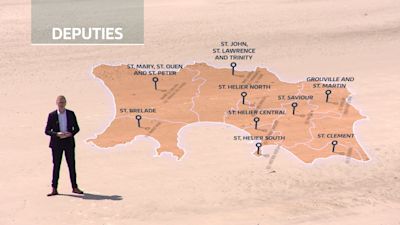Explainer
Jersey’s new-look electoral map: The changes explained

Report by ITV Channel TV's Tom Johnston
Changes agreed by politicians in 2020 have led to the biggest political shakeup of Jersey's States Assembly in generations.
It is hoped the changes will make Jersey politics more representative and encourage more people to use their vote, by reducing the number of uncontested elections in the island.
What are the changes?
For the first time in 74 years, there will be no Senators elected to the Assembly, with the island’s electoral map redrawn to accommodate eight more Deputies to replace them.
The twelve Constables - the most long standing representative role in the Chamber - will still be elected on a Parish basis and will still have the same full voting rights as other members.
So the States Assembly will now be made up of:
While Constables will still be elected on a parish basis, Deputies will now be elected in nine new constituencies. They are:
Grouville & St Martin (3 Deputies)
St Brelade (4 Deputies)
St Clement (4 Deputies)
St Helier North (4 Deputies)
St Helier South (5 Deputies)
St Helier Central (4 Deputies)
St John, St Lawrence & Trinity (4 Deputies)
St Mary, St Ouen and St Peter (4 Deputies)
St Saviour (5 Deputies)
Why have the changes been introduced?
The new boundaries have been drawn up in a bid to rebalance the number of representatives in line with the population of the island, based on data from the most recent census in 2011. For example, St Ouen is the island’s largest parish by area but has one of the smallest population densities in the island. Under the changes, each Deputy will represent around 3,000 people on average.
The hope is that the changes will also lead to less uncontested elections among Deputies. While uncontested votes are more common among Constables, three Deputies were elected unopposed in 2018.
What other changes are being made?
For the first time at this election, the ‘none of the above’ option will be included on the ballot paper in any vote where the number of candidates standing for the role is less than the number of vacancies.
For example, if there are three candidates standing for the role of Deputy in a constituency with five seats to be won, voters will be able to select ‘none of the above’ to say they don’t want to vote for any of those candidates.